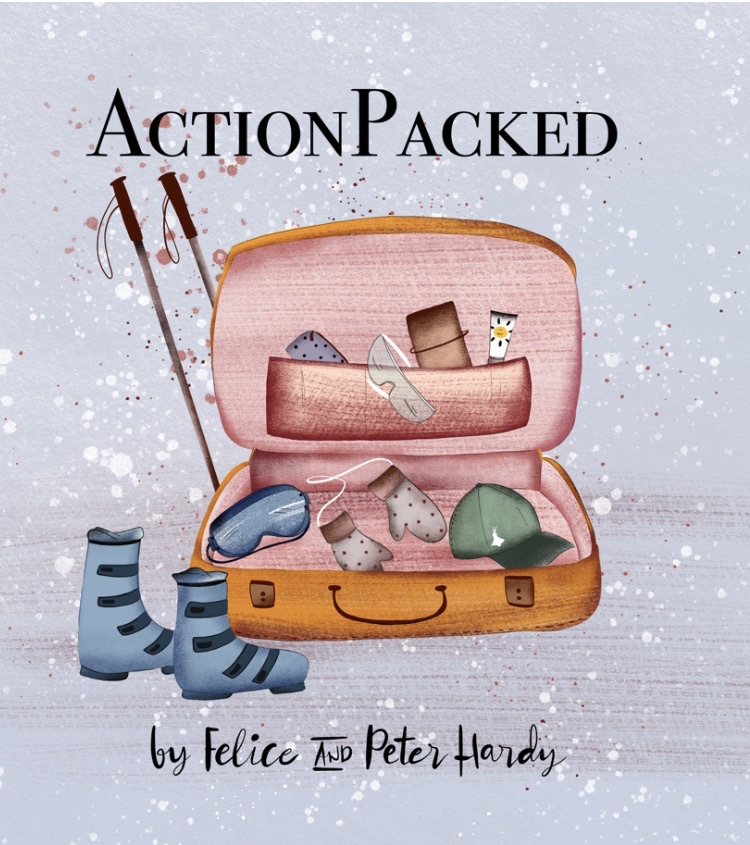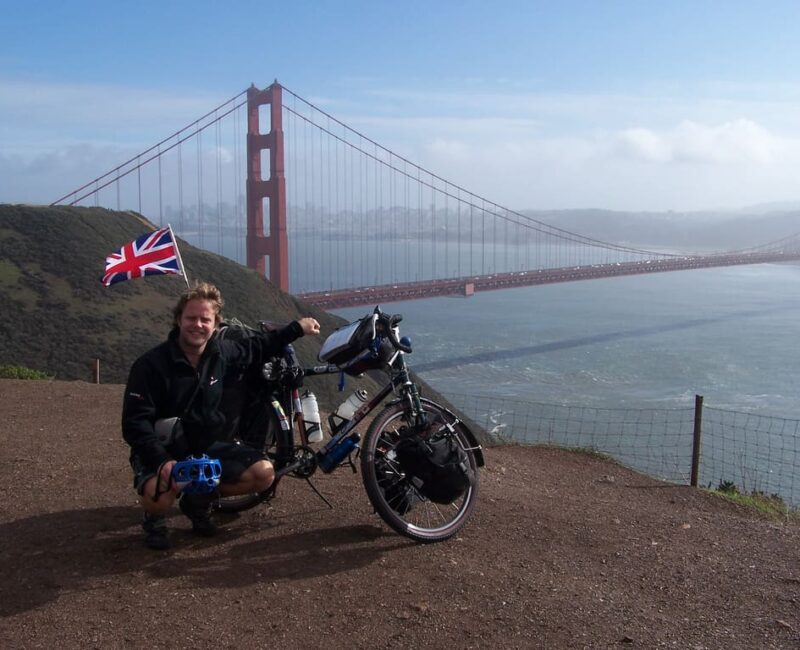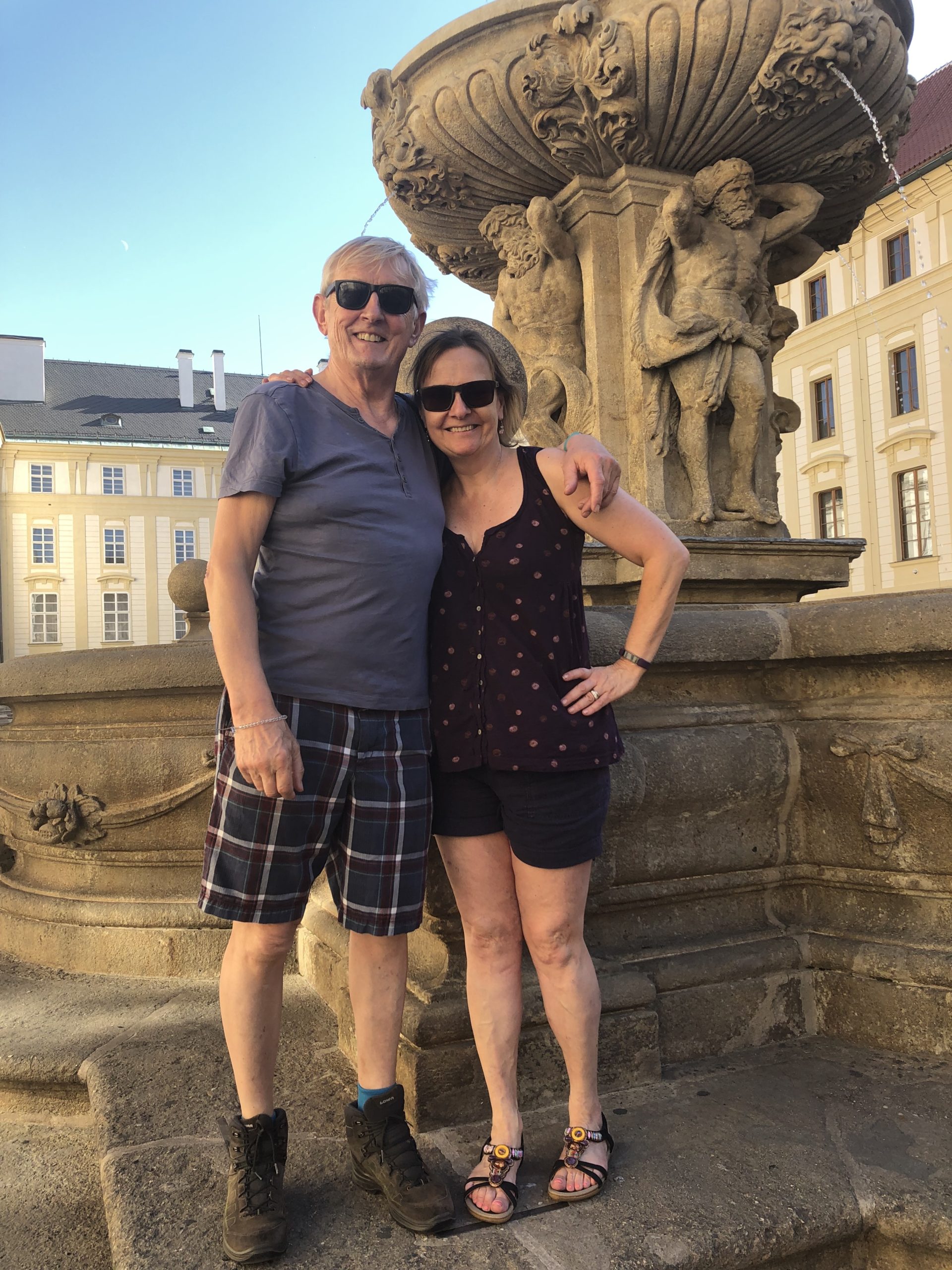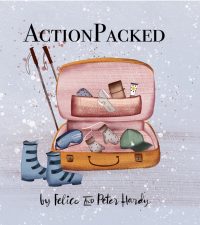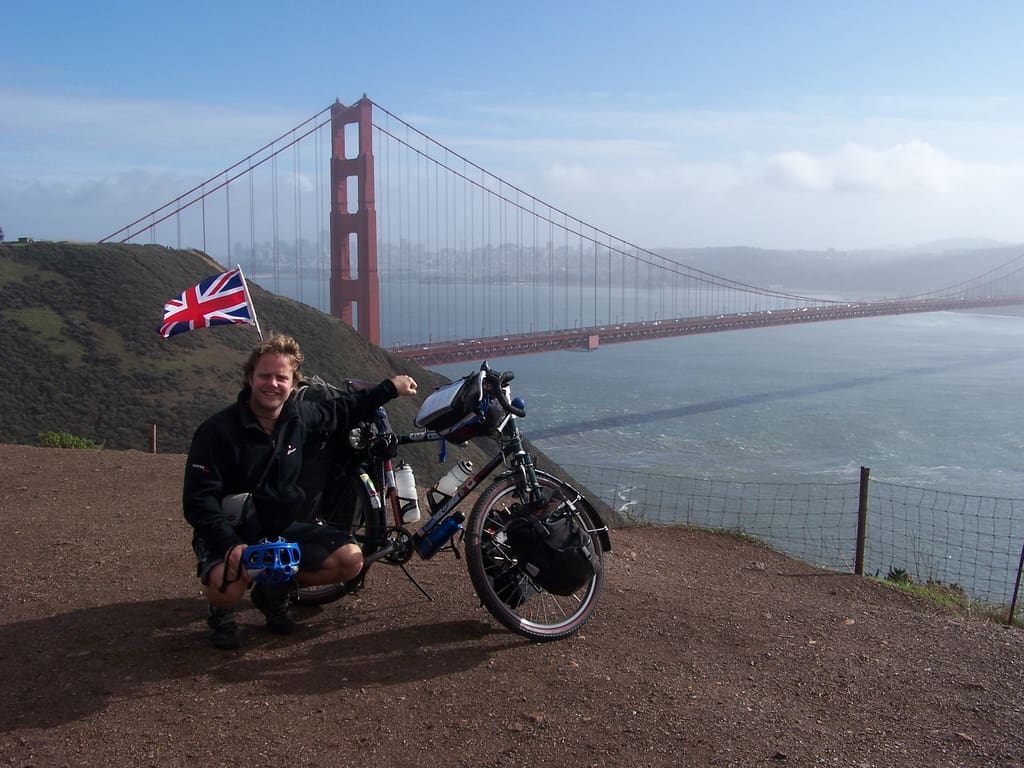
The Hungry Cyclist at Golden Gate Bridge, San Francisco
Peter Welcome to our travel podcast. We’re specialist travel writers. And we’ve spent half a lifetime exploring every corner of the world.
Felice So we want to share with you some of our extraordinary experiences and the amazing people we’ve met along the way.
Peter This week, we’re talking to Tom Kevill-Davies, The Hungry Cyclist. Tom has managed to carve a highly successful career for himself out of his twin passions: cycling and eating. You’ll find him and his wife at the seventeenth-century watermill in Burgundy, that he’s lovingly restored into the Hungry Cyclist Lodge.
Felice The idea is really simple. By day, with or without Tom as your guide, you cycle around the vineyards of this historic region. Then when the sun goes down, you relax over a glass or two of fine local wine in gorgeous rural surroundings. Meanwhile, Tom creates magic in the kitchen for you.
Peter For Tom, it began with a gastronomic bike ride all the way from New York to Rio de Janeiro as he gorged himself on local cuisine and gathered recipes in the 10 countries on his route. To find out what drove him to paddle all that way. We went to meet him.
So, Tom, where did this idea of cycling across America and indeed cycling in general, when did all begin for you?
Tom Well, I’ve always loved cycling, always loved riding a bike, and then moved to London after school to study and work. And being a student in London wasn’t easy in terms of transport – the travel card was expensive. So I cycled to and from art school and then got a job and cycled to and from work. And these are the days when not many people were cycling in London – and just absolutely loved it and got better at it. And at weekends I would disappear on little adventures. But it was really a trip cycling from London to the south of France in 2004 that opened up the joy of long-distance cycling.
I did it with a friend. He gave up on the second day. And so I went on by myself and nine days later arrived in the south of France and really just felt what a wonderful way to travel. At that point I was twenty eight, I hadn’t travelled, gone straight from studying to to college to a job. And I suddenly had this means of transport that I loved and just thought it would be great to travel. And within a year I handed in my notice, quit my job, sold most things, bought a fancy bicycle – or relatively fancy bicycle, and then flew to New York with the idea of cycling to Rio de Janeiro.
Felice Well, how many miles is that?
Tom It’s about 20,000 kilometres. So I’m getting more and more French….So it’s about 12,000 miles. And it took two and a half years, which isn’t the fastest you could go.
But I love food and eating and gastronomy, and so my objective on the trip was to…I thought I needed something to do – I like projects – was to collect and research as much about the local cuisine in the places where I was as possible. And anyone know when you saw a touring bike, you were hungry all the time.
Felice So what did you carry with you on your bike?
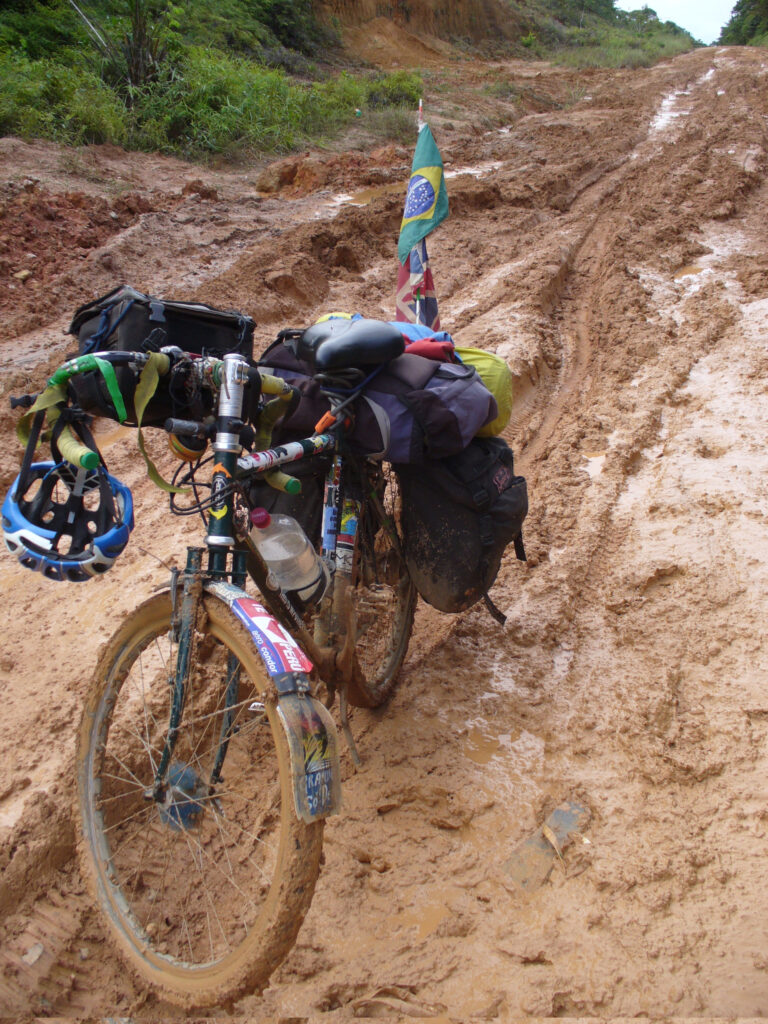
Bike in the mud at Bahia, Brazil
Tom Started off pretty green and carried way too much. Then after about a month, I gave it to charity shops or other cyclists. You needed it, but tent, waterproof clothing, a stove, an inflatable mattress. I mean, the Internet wasn’t as powerful as it is now, so you’d go on forums and say, ‘what do I need for a long bike tour?’ And, you know, suddenly ended up in my small bedroom in my flat was just full of all this kind of adventure. Yet after about a month, you realise you don’t need it.
So, yes, I carried way too much. And quickly, as I suffered up the hills of upper New York State and into Canada, realised that I was carrying too much, I stripped it right down there.
Peter So that’s the way you went. What was your route?
Tom My route was certainly more scenic than practical. So I went from New York up to Toronto. I went round the Great Lakes and then cut back in and went all the way across America and over the Rocky Mountains to Vancouver and then all the way down the west coast of America into Baja California, and then into all the way through Mexico, Guatemala, El Salvador, Honduras, Nicaragua, Costa Rica, Panama, Colombia, Ecuador. And then took a bit of a detour and crossed the Andes and went down into the tributaries of the Amazon and followed the Amazon on various boats all the way to the mouth of the Amazon in Belém in northern Brazil, and then followed the coast of Brazil down to Rio de Janeiro.
Felice This sounds incredible. And where you on your own the whole way?
Tom It was, yes, I was on my own the majority of the way. I met an Israeli cyclist in Santa Barbara, California, called Amir. He had done six years in the Israeli navy. And it basically he was off to go and clear his head, I think. And I met him in a youth hostel and he said, ‘Where are you going?’ I said ‘Brazil.’ And he said, ‘Well, I’m coming with you.’ We cycled all the way to Nicaragua together, but he fell in love with someone along the way and that got in the way. So I went on by myself.
Felice How do you meet people to fall in love with on the way?
Tom I can’t discuss that! Let’s just say he was very persuasive. You know, we met on New Year’s Eve in Santa Barbara, and I said, ‘I’ll take you out for dinner,’ and we went out to dinner and there were a couple of girls at the table opposite us, and Amir very boldly and in a wonderful Israeli way went up to them and introduced us. And I ummed and ahhed and they said, ‘We’re going to a house party later. Do you want to come?’ And so we said, yes, OK.
And then about 3.00 in the morning, I was sitting in the kitchen eating, probably, and Amir just came and tapped me on the shoulder and said, ‘Tom, I’ll be back in two days.
I’ve met someone.’ And so I waited in the house of the house party for two days, sleeping on the sofa. And then Amir came back two days later, said, right, let’s cycle to Mexico. Yes, that was his that was his amorous moment, and he then went back.
Peter And then eating…the eating side. The idea was to eat on the way?
Tom And really, I found it on the trip in France that I love to eat a lot of food and I always have. And the idea was if you’re on a big bike ride, one of the three things you have to do every day is eat – and that might as well be your main focus. And also you’re burning so many calories, you can eat whatever you want. I just found it very interesting thing to follow. It’s a lovely way to get access to people, the culture. You know, people speak a lot of that in America, not so much.
But when you get into developing countries and you get to Mexico, for example, people say, ‘What are you doing?’ And if you just say, ‘I’m cycling from New York to Rio de Janeiro,’ they can’t really get a handle on that. It’s a very obscure objective that I think if you’re from England or America, you can get that because we have the luxury to do that kind of thing. But I would say cycling and collecting recipes and immediately, ‘Ah, well, in this village, we do this; this is our speciality. You must stay for the weekend because we have this local fiesta when we cook this or cook that.’ And the next thing, you’re getting to meet people and they’re cooking for you and you’re cooking with them and they’re just showing you what the cuisine is. And you learn so much about people by what they eat, I think.
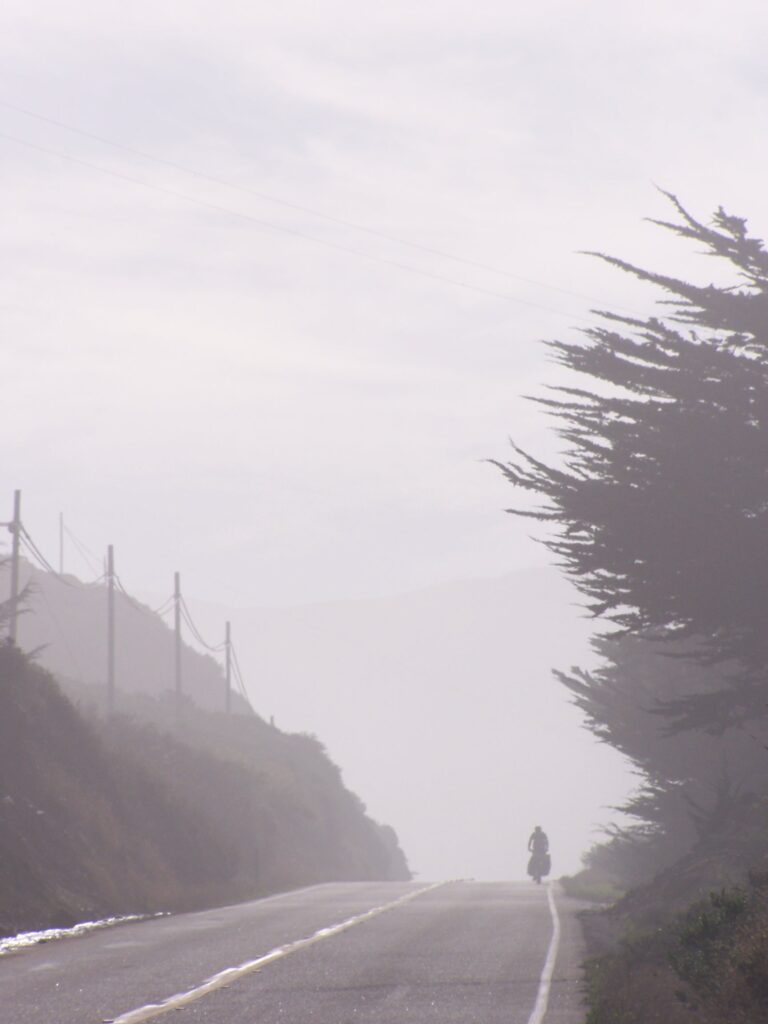
Misty morning in Guatamala
Felice Did you take notes and things like that?
Tom I wrote a diary every evening or every lunchtime, depending on when I felt like doing it. And I’ve got it in a box downstairs here. I’ve got dozens of notebooks that once they were full, I’d put them in in a jiffy bag and send them back home. When I got home, they were all there and I did lots of sketching and a bit of photography.
And it was a very analogue trip, I think. I did the trip just before digital adventuring really took off. And, you know, Facebook didn’t really exist and Instagram certainly didn’t exist. I looking back, it was a lovely way to record a trip. I often think it must be lovely now with, you know, with an iPhone you can record audio, you can take photos, you can do this stuff. And I was doing it with a pencil in the pouring rain, in a notepad, and doing watercolours and sketches, which makes it sound like some kind of nineteenth-century trip. But that was really how it was. If you wanted to call home, it was an Internet cafe.
Felice So did you plan on writing a book before you went?
Tom No, I didn’t. I wanted to take notes. And once I started going, it got a following of its own. And I started writing an email newsletter to friends and family. I had worked in advertising before I left, so I knew how to build a website which was in those days pretty cool. So I had this little website and I’d email this growing group of people on this email list. And it got out to quite a lot of people.
And then it got heard by Radio 4’s Excess Baggage, which was the Radio 4 travel show. And they followed the trip and they called me up and say, ‘Can we speak to you? We’ve got a ten-minute slot this weekend,’ and I’d have to find a good phone line in some Colombian village. And I’d call in and then after that, it really picked up.
And a lot of people started following the trip and people in the publishing world started following it and got in touch and said, ‘If you’re ever interested in writing a book, this would be really interesting.’ And I said, ‘I’m in Southern California. I’ve got a long way to go, so I’ll let you know, but I’ll keep taking notes.’
Peter So tell us about the highlights. What was the best food you ate along the way?
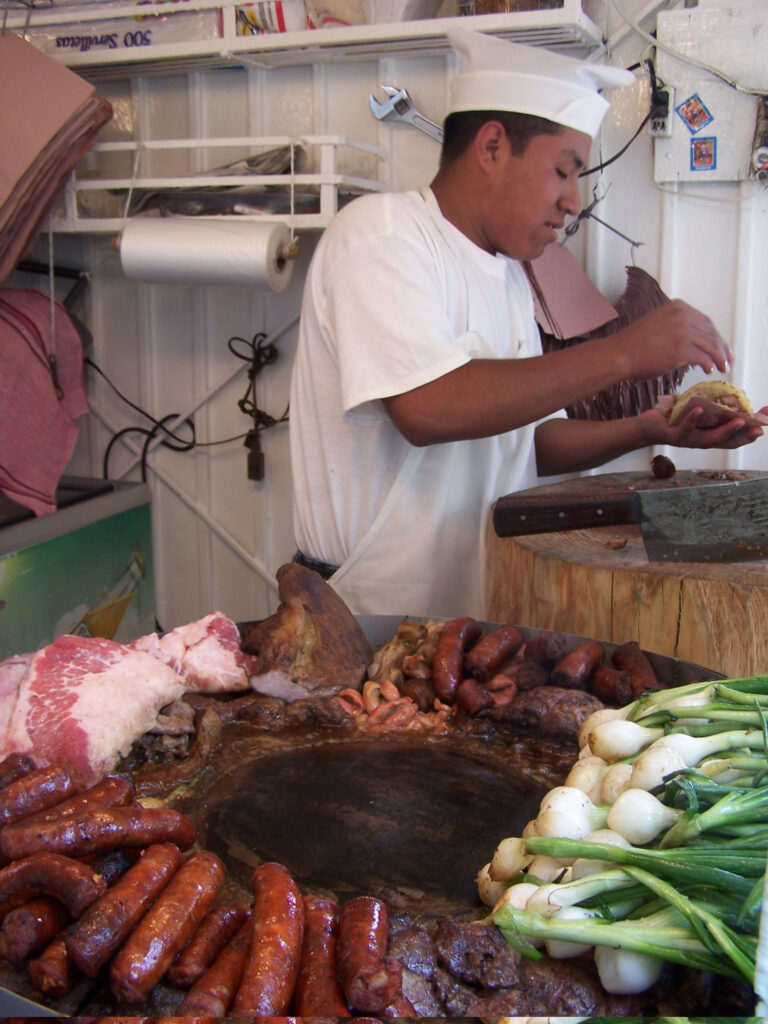
Taco stand, Sinaloa, Mexico
Tom Best meal? I’ve just written an article about the experience of eating fish tacos in Mexico. So that is very in the forefront of my mind and my taste buds at the moment. And they really are exceptional. So that when you cycle on the Pacific coast of Mexico, there’s a strip of land called the Baja California. And it’s this desert peninsula that runs from Tijuana down to La Paz, and it’s very hard cycling. It’s mountainous, desert, cactus forest, so you’re getting a lot of punctures. There is no shade and the only other people on the road are just heavy trucks or motorhomes of Americans who are driving down to the southern beaches to escape the winter. And they’re pretty unforgiving. And you sleep in the desert. It’s just hard, hard work.
But when you get to the inside of the peninsula, the Sea of Cortez, and they have all this fishing; the fishing there is one of the most abundant oceans in the world – or seas in the world. And it’s full of all these lovely fish. And the fishermen there, they basically sell their catch to people who sell fish tacos, which is just morsels of the lovely fish that are deep fried and served in a tortilla. But then you add various salsas and sauces, and they’re only served in the morning when the fish is fresh.
So if you can imagine, you’ve been cycling about 100 miles in the desert the day before, you sleep rough in the desert, wake up at about 6am and arrive in the next fishing village. And then there’s this lovely lady in a kind of makeshift kitchen stand selling this wonderful fish tacos and I’d just eat hundreds and hundreds of them. They were absolutely delicious, so fresh, so lovely and local. Wonderful.
Felice And when you were sleeping rough in the desert, did you come across any wildlife?
Tom No, no, not there. I mean, there you’d hear a lot of wildlife and then your imagination would go, ‘What was that?’ And you’d make horrible imaginations. So no, otherwise no. In Canada, in the Rocky Mountains, I saw a lot of bears. And when you’re sleeping in a tent up there, you have to be very careful about what you do with your food. You have to hang it in a tree before you go to sleep. And a couple of nights I’d hear bears but I’d have a fire and I’d hear bears out at my fire outside, and that’s really terrifying.
Felice And you were just in a tent?
Tom Yes, just in a tent, just in a one-man tent. A great big thing breathing outside.
Peter You had a fire?
Tom You’d have a fire, a little fire outside and I cooked whatever I was cooking. And then you’d get in the tent, stay as warm as possible. But I sleep very lightly. I think when you camp, you sleep very lightly, especially when you’re by yourself.
Peter Especially when their bears around.
Tom Especially when there are bears. They give you a bear bell, which is a little bell that apparently you ring and then the bear knows you’re there and isn’t interested anymore. I didn’t have much confidence in a Christmas tree decoration against the bear. I’m not sure that’s adequate.
Felice So did you eat any really horrible food, something you really didn’t like and wouldn’t have again?
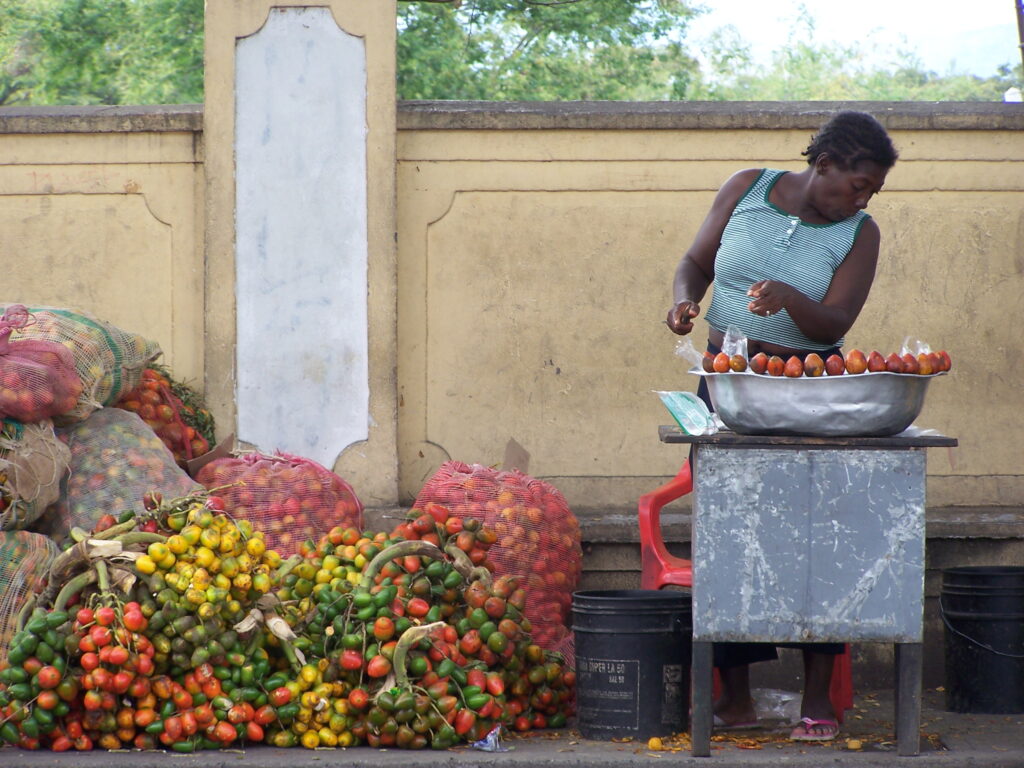
Fruit stall, Cali, Colombia
Tom I eat pretty much everything. The Amazon – when I followed the Amazon river from its from its source to the sea, I think it was about the third boat I was on. It was this kind of rusting cargo boat and I was on it for eight days. And with your ticket, which is not much, you basically get a place to hang your hammock and you get a meal in the morning and a meal in the evening.
And I remember going downstairs and the mechanic was the same person who cooked the meals. And then you’d go down and you queue up a bit like being in prison. I mean, I’ve never been in prison, but I imagine you queue up with your metal bowl and they just ladle all this slop into it. And I think they were just catching fish and then just boiling it in this gross, big old dirty metal pot. And they just ladle it in and it had some kind of polenta in it. And it was bones and gristle. And the guy serving it was just covered in oil and was in the engine room and sweating. And it was a bit like…it’s one of the only times in my life where you put the spoon in your mouth and your body is like ‘I’m not doing that,’ and you have to remind yourself you’re going to eat it. So that’s probably the worst experience.
Peter What about illness? Were you ok?
Tom I was Ok – you get you get stomach upsets and you get obviously leg problems and knee problems and back problems because you’re doing something very physical. I arrived in Oaxaca, in Mexico very late in the afternoon. Oaxaca is the culinary mecca of Mexico. It’s the kind of place of gastronomy that everyone had been talking about, how wonderful it is.
And I arrived really late in the afternoon and went straight to the central market to find some food. There wasn’t much going on, but they had this cheese, there, Oaxacan cheese, and they lure people in because it’s a bit of a tourist destination as well for food, and they holding out free samples of the cheese in the market. And I was so hungry that when I arrived, these people were handing out platters of this cheese.
I just took as much as I could and then started feeling really sick that night, realised that the cheese had probably been sitting on the platter all day in tropical heat. You know, I had about two days where I couldn’t really hold anything down. So I went to just went to a pharmacy and explained and they said, ‘Are you allergic to penicillin?’ And I said, ‘no.’ They said, ‘Well drop your trousers,’ and then put a penicillin injection into my bum. And 24 hours later, I was fine. So don’t eat cheese late in Oaxaca market, that’s the moral of that story.
Peter And how do you cross the Darién Gap that is going from Panama.
Tom Yes, I did the easy option. So when you get there, I only know one other cyclist who’s he’s done it. He did it with a tandem as well, which is extraordinary. But you get to the Darién Gap and the Trans American Highway stops there and you can’t go to Colombia. So you have to either fly from Panama to Cartagena or Bogota, or you can try and hitch on a boat and take a boat around. And I did that. I met a guy, I was at an Internet cafe and I was looking for information on how to do it, and a guy, a Colombian guy, came over and said, ‘You’re looking to do that crossing?’ And I said, ‘Yes.’ And he goes, ‘I’ve got a boat. If you can find five people, you can go for free.’ So I was like, great.
So I went round a few youth hostels, found five other people. And then you go from Belem So cycle to this better this place. I didn’t know the guy other than meeting him in an Internet cafe and these five people turned up. And we spent six days sailing from Belem to Cartagena and it was it was fantastic. It was an amazing trip and nice to not be cycling for a bit.
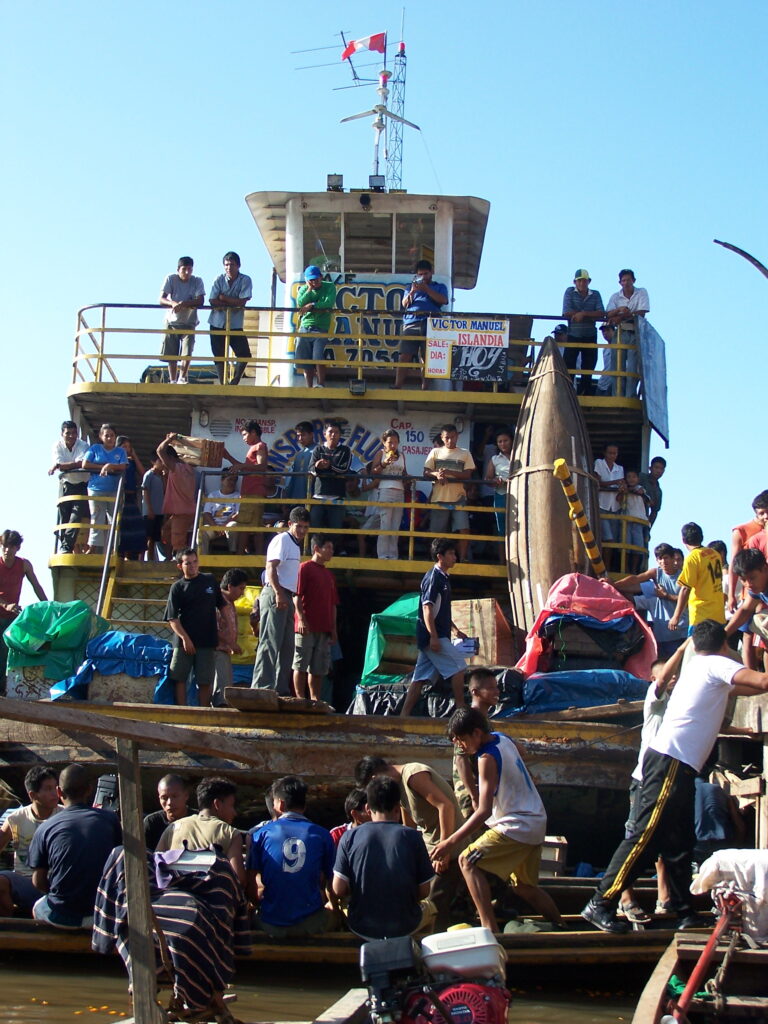
Finding a boat to head downstream in Iquitos, Peru
Felice What about danger? Was there any danger, you know, mugging.
Tom No, I didn’t get mugged, thankfully, I only got a few bits and bobs stolen. You know, if you leave a penknife on a table or stuff like that, or sunglasses. I had a shower when I was going down the Amazon, I left my money belt hanging up in the shower cubicle, went back and they’d taken the money but left my passport. So I was quite grateful. Yes, nothing really.
I think a cycle tourist is quite a strange animal. You know, you’re rarely in the tourist hot spots. And so I think by the time people see you they’re like, ‘What on earth is that?’ if somebody wants to rob you, ‘What animal is that? How do I approach and attack that?’ By the time they’ve figured it out, you’re just this big kind of hairy, sweaty object suffering along. And you’re cycling so people maybe have a bit of empathy for that.
Peter What about punctures?
Tom Had to from New York to San Diego, and then after being in the Baja California, where the the spines of the cactus are inches long. And then that’s just the big ones that you can see, there’s various other kind of small cactus that spread their needles all over the road. And I had 18 punctures in one day. And that’s soul destroying. And you’re doing everything you can, you’ve repaired every spare and achieve. You’ve got you taking the tires off, with no shade stopping in the middle of the day. And the bike, especially if it’s the back. At the front. ok, but when it’s the back wheel you’re going to basically take the whole bike apart. Just a nightmare.
Felice Eighteen – so did you have enough equipment?

Tom Yes, well, I always had spare tubes and then puncture packets and stuff like that and I was with Amir at the time, my Israeli friend and so he had kit as well. That was eighteen between the two of us. So yes, it was awful. It was absolutely awful. And by the end of the day, we were just angry with the bike, angry with each other. You’re angry with yourself. You arrive in the evening in a little hamlet that’s got a taco stand and a cold there.
And you have your tacos and your cold beer and you ask the owner if you can sleep in a little field behind his shed and he goes, ‘No problem’. And you sit under the stars and you forget about it all. And the moment you think about quitting, you think, actually, I might have another go at this tomorrow.
Peter Where there any serious moments of quitting?
Tom Yes, lots and lots. That’s part of the joy of it. I mean, there are, but it’s like the scene I’ve just described. Yes, you quit often, but then by the time you’re on a bike and you’re in the middle of nowhere… let’s say you quit in the hills of Colombia, you’ve then probably got five or six days to get to the nearest town, at which point you can get a bus, at which point you can get to Bogota, you can book a flight and then go home.
So you’ve got all these little points to question your decision to quit. And normally after ‘I quit, I’ve had enough,’ then by that evening you’ve had such a magical experience, the sun goes down, you arrive at a little village, there’s children walking home from school, there’s salsa music playing, there’s the smell of grilling meat on a barbecue. You pull up, you eat something lovely. Someone says, ‘Oh, what are you doing?’ ‘Oh, I’m cycling to Brazil.’ ‘Oh, you can sleep in my house.’
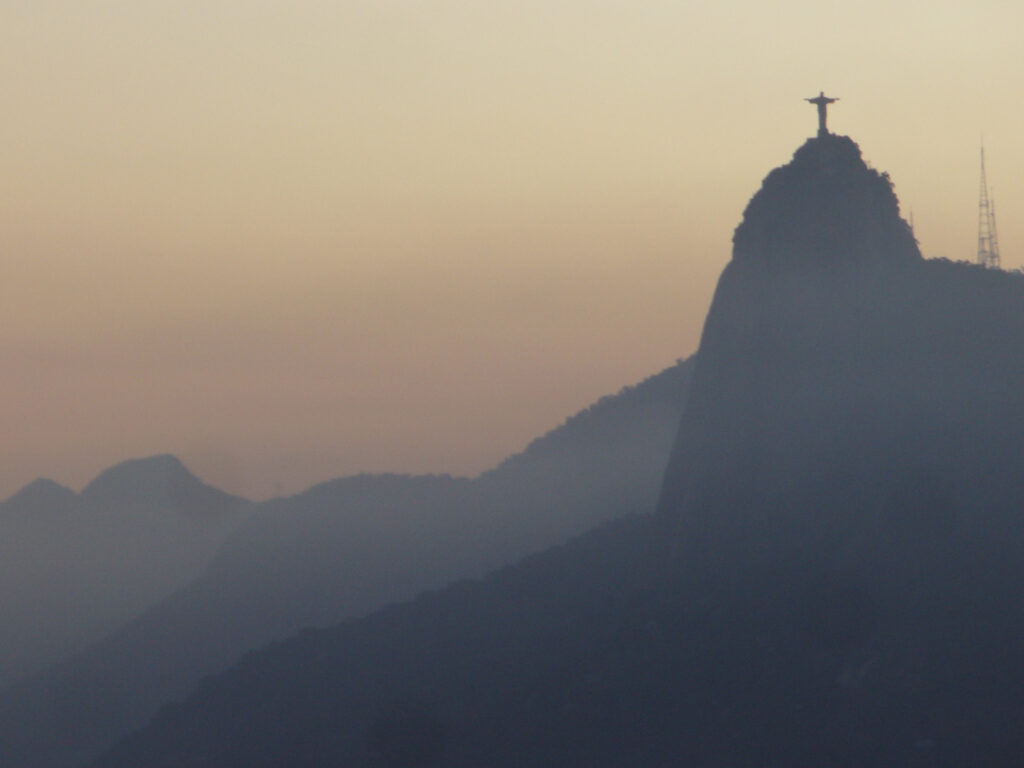
The final destination: Rio
Peter A pretty good feeling arriving in Rio then, was it?
Tom It was a wonderful feeling arriving in Rio, and Rio is magical because obviously, if it’s been your destination for two and a half years, you know it’s going to feel pretty good. And when you cycle in Brazil, Rio, even if you live in Rio de Janeiro is a very overused image. You know what it looks like before you get there.
And I think with a lot of places you see, if it’s the Leaning Tower of Pisa or Paris or the Eiffel Tower, when you see it you say: ‘Ok, I’ve seen the pictures. That’s impressive. I’ve seen the pictures,’ but when you arrive in Rio, you’ve seen that, you’ve seen the images, but there is no image that compares to its beauty. It is the most stunning city that I’ve seen. You arrive and you go around the corner onto Ipanema Beach and the city just falls into the ocean and it’s dwarfed by these wonderful verdant mountains. And the beach is just full of beautiful people running around being happy and doing lovely things. And it’s just an incredible place.
Peter How long did you spend in Rio when you got there?
Tom I spent about nearly three weeks in Rio when I when I got there.
Peter And then it was time to head for home?
Tom I believe it was. And then I had a bit of I had a bit of money left – and I had a bit of time left on my visa, most importantly. When I’d stopped a few times along the way. I just enjoyed surfing. I took that up because it was quite a nice way to relax. And I rented a little shack off a fisherman for two months just south of Rio de Janeiro and surfed every day for two months and kind of got my head together and then flew home.
Peter When you got home, was that a strange experience to be in one place?
TomYes, it was. I was definitely ready to go. Well, I think that’s the other thing, you kind of know when it’s when it’s time to go home. And initially it was great because you see your friends and you see your family, but then it becomes evident very quickly that this kind of fairytale existence for over two years where you haven’t had any responsibility other than waking up and making sure that your pedals turn around…and suddenly you have to kind of get back into real life.
And I was lucky that a publisher was interested in the story. So I initially I had a project to write the book very quickly. And that enabled me to have an objective very quickly, which I think was incredible, because otherwise I’m not sure what would’ve happened, to be honest. It’s a bit different.
Felice What did you do next? When did you think up the idea of starting a holiday based around cycling?
Tom Yes, a good question. The idea of the cycling holiday came in Mexico when I was cycling along and with Amir at the time, and we were just talking about what are you going to do after this?
And at that point, you’re very dreamy and all that kind of thing. And we talked and I’ve got the notebook with the notes in it, and I write a lovely one day to have like a place where people could come and ride bicycles, eat well and sleep well and just have a nice experience around eating and cycling.
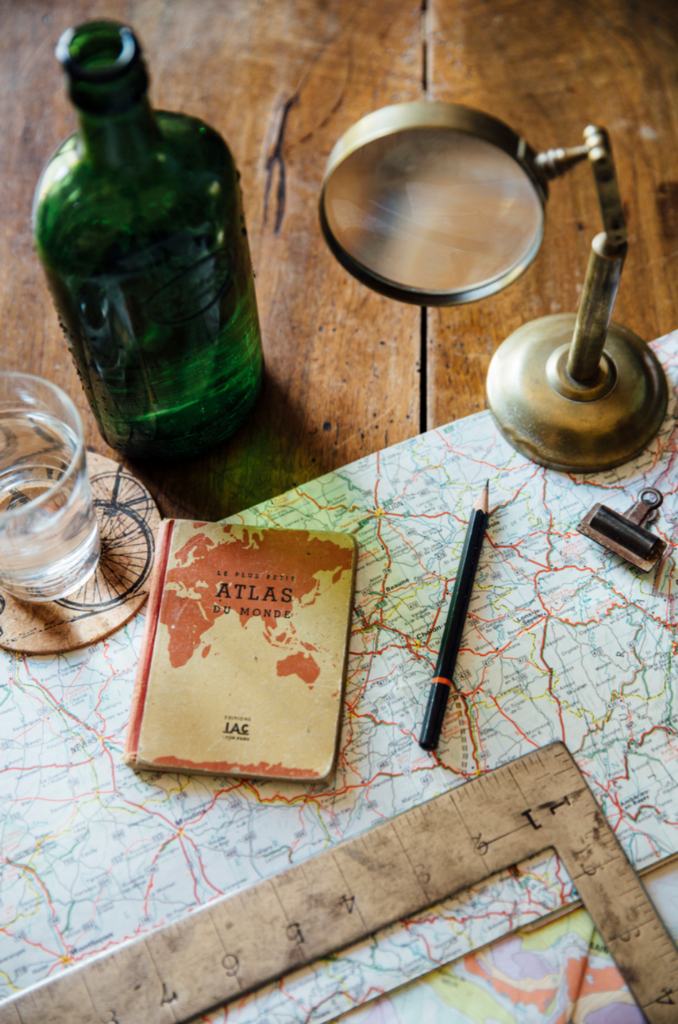
Photo: © The Hungry Cyclist
But then you come home and you get a book deal and you write the book and everything changes again. Writing a book is a very monastic mission, like riding a bike by yourself. You’re by yourself again, but you’re writing. You’re being very disciplined, you have to be very strict. And then the book was written, it gets edited, it comes out and and then you’re kind of….well, for me, I was ‘You know, I’m a food and travel writer. I’ve got to do that.’ And it’s not really your choice.
So I did that. And then I went on some other big cycling trips and write articles and cycled around Taiwan, around northern Spain, a lot in Germany, the Middle East, and wrote articles. And that was that and working for antique dealers that was my living. And then decided maybe I should write a second book and decided to cycle the length of the Mekong River.
So, I then spent 10 months doing that. And it got to a point where I was in the mountains of Hunan in southwest China. I just was like, ‘What are you doing?’ When I was the other trips, especially on the Americas trip, to go back to the question of quitting, you’re like ‘Well, if you quit, what what could you be doing better with your time right now?’ I always said, I’m going to rest, get my head together and then ask that question. And until then, it was keep writing the book and writing about food and eating and taking photos and sharing all this lovely information.
And then at that point I was like, ‘You could be doing something better right now.’ I was basically had enough of long-distance solo cycling. So I’d been offered a job. I met a Canadian guy who had a restaurant in Luang Prabang, which is a city on the Mekong River in Laos, and he said, ‘I want to adapt the restaurant, will you help me?’ So I went back and worked there for six months setting up a restaurant in Laos, which was amazing.
And then that came to an end I came back to England and said I want to set up this holiday cycling business. How do you do that? And I asked a few friends. And actually Amir was now running cycling holidays in Israel. He worked for an American company and they were looking for people to guide cycling holiday. So I applied to them and they gave me a job. And for three years I organised cycling holidays all over Europe.
And in the meantime, when I wasn’t guiding Americans around wineries and chateaux and picturesque French villages, I was looking for places I could do what I’m doing now, which is a lodge, where I can cook all the food, people come and stay, ride bicycles, drink loads of wine – or drink nice wine quite a lot.
Peter So you found the right place there?
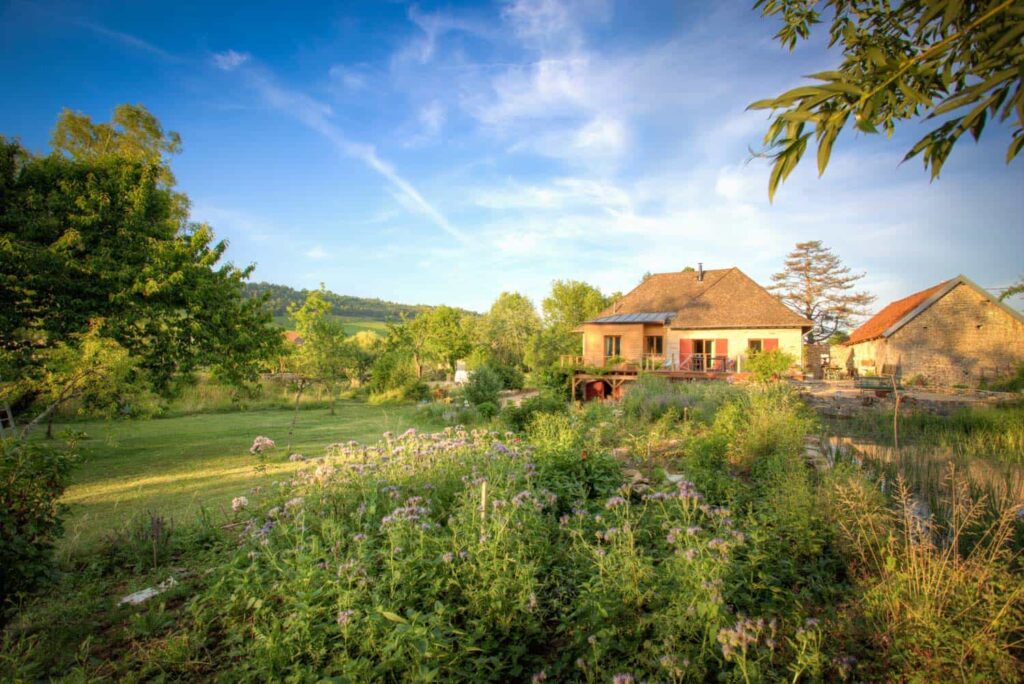
The Hungry Cyclist Lodge
Tom I found the right place, which was. Well, it’s certainly the right place now. I found it in Burgundy, which is in central France. It’s a wine region, it’s a very foody region, people call it ‘the stomach of France.’ The food is great, the wine is great. And while I was leading tours for the American company, I spent quite a lot of time here in Burgundy, rented an apartment and then found an abandoned seventeenth-century watermill.
Peter And then you met your wife along the line somewhere?
Tom I met my wife here in the village. And though, yes, this is a nice place, but took it took about three or four years to persuade her that I was not totally insane. And we got married two years ago.
Felice Tell us if people want to book cycling holidays when they can, when things get better or now for the future, where do they find you? What’s it called?
Tom It’s called The Hungry Cyclist and it’s in the Hungry Cyclist Lodge. You can find it at thehungrycyclist.com.
Felice And if people want to read your book, what’s that called?
Tom That’s called The Hungry Cyclist.
Felice That’s easy!
Tom Well, that’s consistent branding. Can get the name. Yes, they can buy that on Amazon and Kindle and in small independent bookshops.
Peter So what will you be doing in five years time?
Tom So I’m looking to develop a second lodge here in Burgundy. I love renovating old spaces, I’ve decided. I love gardening. So maybe have a second one of these, but with a different vibe, maybe in a bit more of a town. This one’s very much in the countryside, but maybe find a building in a small town and renovate that and just maybe some children, lots of time in the garden, welcoming people from all over the world, not having to wear a mask. That would be great.
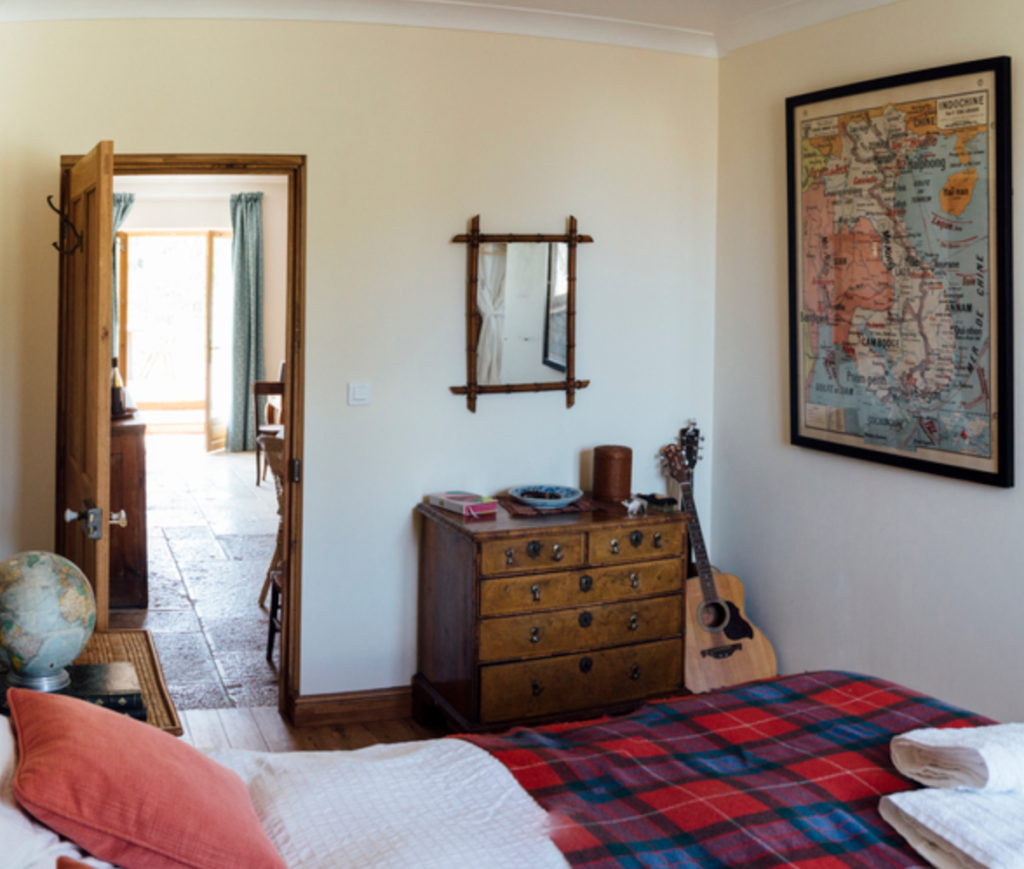
A bedroom at the Hungry Cyclist Lodge
Felice So what’s the mill like? What people come and stay in that with you?
Tom Yes, people come and stay. So we live in the old bar, which is next door. I mean, it started off with three bedrooms and I just slept wherever whenever I could. And now we have a little mill where we live next door, and here we have five bedrooms. And we also have the old baker’s cottage. So when it was the mill, they baked bread in a separate building, and that’s a cottage as well. So we’ve got five five en suite rooms and a little cottage as well. So it’s great for groups, great for families, nice big garden. Try and grow as much as the food, fruit and vegetables as we can here. Lots of chickens and ducks. That’s great fun.
Peter And you do guided tours or do people self guide?
Tom A bit about everything ready. So we you can either do self guided. A lot of people just come and stay and we rent them a bicycle or they bring their own bicycle and we send them off on various circuits that we have in an application. And then some groups come and they want me to take them round. I’ve picked up a fair bit of wine knowledge and it’s a fascinating kind of culinary, wine, historical region Burgundy. So sometimes if people want to, I can guide them, and I work with other local guides as well.
Felice And what about your surfing? Do you still do that?
Tom No, I tried last year. My wife and I went to Sri Lanka and talked with great bravado of my time surfing in South America and went out to try and impress her. I looked like a half suffocated codfish on the chopping board. It was very embarrassing.
Peter Tom Kevill-Davies, thank you very much for appearing on our show. And we wish you the very best of luck with all your future travels.
Tom Thank you very much. Thank you for having me.
Felice That’s all for now. If you’ve enjoyed the show, please share this episode with at least one other person! Do also subscribe on Spotify, i-Tunes or any of the many podcast providers – where you can give us a rating. You can subscribe on Spotify, Apple Podcasts or any of the many podcast platforms. You can also find us on Twitter, Facebook and Instagram. We’d love you to sign up for our regular emails to [email protected].
© ActionPacked Travel
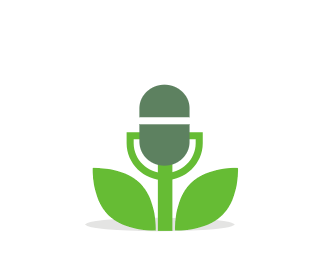
- Join over a hundred thousand podcasters already using Buzzsprout to get their message out to the world.
- Following the link lets Buzzsprout know we sent you, gets you a $20 Amazon gift card if you sign up for a paid plan, and helps support our show.
